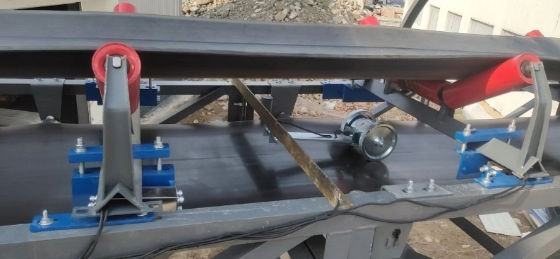Belt scales are automatic scales that continuously weigh bulk materials on a conveyor belt without subdividing the mass or interrupting the movement of the conveyor belt. The main classifications are by carrier: weighing bench-type carriers, conveyor-type carriers; by belt speed: single-speed belt scales, variable-speed belt scales.
working principle
The electronic belt scale weighing bridge is installed on the conveyor frame. When the material passes by, the metering roller detects the weight of the material on the belt conveyor and acts on the weighing sensor through the lever, generating a voltage signal proportional to the belt load. There is a weighing sensor installed on the belt scale on the weighing bridge. When working, the weight of the material on the belt is detected and sent to the weighing instrument. At the same time, the speed signal of the belt conveyor from the speed sensor is also sent to the weighing instrument. The instrument integrates the speed signal and the weighing signal to obtain the instantaneous flow rate and cumulative amount. The speed sensor is directly connected to the large-diameter speed drum and provides a series of pulses. Each pulse represents a belt movement unit. The frequency of the pulses is proportional to the belt speed. The weighing instrument receives signals from the load cell and speed sensor, obtains an instantaneous flow value and cumulative weight value through integral calculation, and displays them respectively.

Classification
Classification by carrier: weighing bench-type carrier, conveyor-type carrier; Classification by belt speed: single-speed belt scale, variable-speed belt scale.
According to the weighing principle: there are mainly two categories: mechanical type (the most common one is roller belt scale) and electronic type.
The scale frame structure of the electronic belt scale load-bearing device mainly includes four types: double lever multi-roller type, single roller type, cantilever type and suspended type. Electronic belt scales with double-lever multi-roller and suspended scales have a longer measuring section, usually 2 to 8 sets of rollers, with high measurement accuracy and are suitable for places with large flow rates and high measurement accuracy requirements. The belt speed of electronic belt scales with single roller type and cantilever scale frame can be determined by the manufacturer, and is suitable for places with small flow rates or places where flow control is used for batching.
Electronic belt scale
The electronic belt scale is composed of a steel mechanical scale frame, a speed sensor, a high-precision weight sensor, an electronic belt scale control display instrument, etc. It can continuously and dynamically measure solid materials.
When weighing, the load-bearing device transmits the gravity of the material on the belt to the load sensor. The load sensor outputs a voltage (mV) signal proportional to the gravity of the material. After amplification by the amplifier, it is sent to the analog/digital converter to become a digital quantity A. , sent to the arithmetic unit; after the material speed is input to the speed sensor, the speed sensor outputs the pulse number B and is also sent to the arithmetic unit; after the arithmetic unit calculates A and B, the material amount of this measurement cycle is obtained. By accumulating each measurement cycle, the total amount of material continuously passing through the belt can be obtained.
Weighing indicators mainly include digital display and Chinese character display. Chinese character display is an upgraded product of digital display. The weighing indicator has cumulative and instantaneous flow displays, and has functions such as automatic zero adjustment, semi-automatic zero adjustment, self-checking faults, digital calibration, flow control, and printing. In addition to the Chinese character display, it can also display speed. The Chinese character display has function display during operation, which can better help users operate.

Mechanical belt scale
Composed of gravity transfer system, rollers, counter and speed plate. The speed of the speed plate is proportional to the belt speed. The angular speed of the roller is proportional to the amount of material passing on the belt. The rolling position of the roller on the speed plate is adjusted by the gravity of the material. When there is no material on the belt, the roller is close to the center of the speed plate, the rotation speed is zero, and the counter does not accumulate; when there is material on the belt, the roller moves to the periphery as the gravity increases, and drives the counter to record the total amount of material passing on the belt.